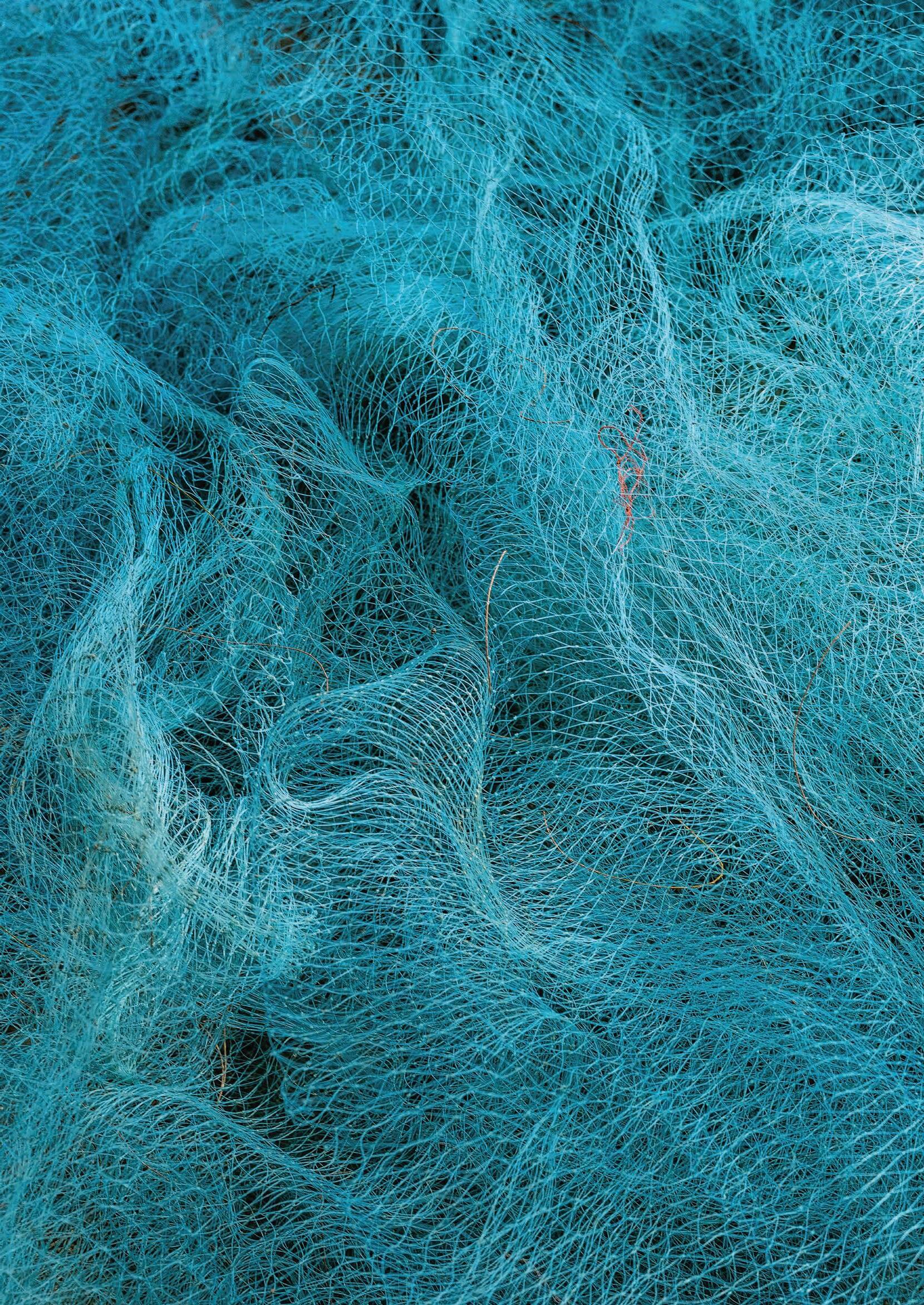




29 APRIL – 18 JUNE 2023
Townsville City Council acknowledges the Wulgurukaba of Gurambilbarra and Yunbenun, Bindal, Gugu Badhun and Nywaigi as the Traditional Owners of this land. We pay our respects to their cultures, their ancestors, and their Elders – past and present – and all future generations.
Publisher
Pinnacles Gallery
Townsville City Council PO Box 1268
Townsville City, Queensland, 4810 galleries@townsville.qld.gov.au
©Galleries, Townsville City Council, and respective artists and authors, 2023
ISBN: 978-0-949461-60-5
Published on the occasion of Leftover Love: New Directions Artists
Carolyn Cardinet
Barbara Dover
Ghost Net Collective – Marion Gaemers and Lynnette Griffiths
Carolyn Menzies
Helen Philipp
Sue Ryan
Publication and Design Development MAK Media
Contributing Authors
Ashley Ragg
Artwork Documentation
Michael Marzik
Epic Media
Marie-Luise Skibbe
Kit Edwards Photography
PINNACLES GALLERY
Riverway Precinct
20 Village Boulevard
Thuringowa Central QLD 4817
Mon – Fri: 9am – 5pm Sat: 9am – 3pm Sun: 9am – 1pm
(07) 4727 9011 galleries@townsville.qld.gov.au whatson.townsville.qld.gov.au
Townsville City Galleries TownsvilleCityGalleries
Is an object or material every truly “leftover”? Goods, possessions, products, and packaging all have their own unique history, both on a personal level, as the products we consume, and in the broader world of commerce, the materials and goods that surround us in our everyday life. For the most part, we are oblivious to what becomes of most of it. That’s entirely understandable because there is just so much “stuff” that is “leftover”.
Nowadays we are aware of the value, importance, and impact of recycling, and we dutifully do our part in giving our post-consumer packaging a “new life”. But what of the stuff we don’t see? The tonnes and tonnes of materials and items that are unwanted, discarded (deliberately or otherwise), that end up in our waterways, oceans, and landfill. This vast, evergrowing amount of leftovers is a useful touchpoint for Leftover Love: New Directions a dynamic and thought provoking new exhibition that shines a spotlight on our relationship with materials, objects, their useful life and their legacy.
In 2021, the Australian Tapestry Workshop curated the exhibition, Leftover Love Leftover Love brought together four contemporary female artists who use textiles or textile techniques to create sculptural forms that engage with ideas around sustainability, environment, and material culture. Three of those artists — Carolyn Cardinet, Carolyn Menzies and Helen Philipp — are now joined by local North Queensland artists Barbara Dover, the Ghost Net Collective (Marion Gaemers and Lynnette Griffiths) and Sue Ryan in an exhibition that expands upon the themes of the original and further examines our relationship to the environment and materials through a distinctive local lens, all driven by a love of leftovers.
That Leftover Love: New Directions is a sculptureonly exhibition by women should not come as a surprise. While historically sculpture has for the most part been perceived as a male domain, typified by large, labour-intensive works in metals or stone, this is now a truly outdated concept. One only has to look to artists such as Louise Bourgeois, Nancy Grossman and more recently Chiharu Shiota’s hugely successful The Soul Trembles retrospective staged at Brisbane’s GOMA
to see why textile-based art is no longer ignored, marginalised or derided as ‘craft’ or ‘women’s work’. Textiles now sit comfortably alongside the established practices of painting and photography, offering its own unique language, nuance and expression.
While the body of work that comprises Leftover Love: New Directions is made up of many diverse artworks it does speak with one voice, and a shared passion for materials and the environment. The materials themselves deliver their own unique creative challenges, “What can I do with this?”. Each of the artists answer that question in distinctly individual ways, that are beautiful, delicate and engaging.
There’s probably nothing more symbolic of industry that adversely impacts our natural environment than finding washed up hard hats on the beach. Barbara Dover’s Illuminate transforms washed up hard hats, along with found wire fish traps and LED lights to evoke the beautiful glowing phosphorescence of underwater creatures, but just as importantly, as she points out, “Working with marine plastic debris raises questions about the detrimental impact of plastic pollution on the marine environment.”
Marion Gaemers and Lynnette Griffiths who make up the Ghost Net Collective share a similar philosophy in their use of marine leftovers and debris, and the finished pieces are just as striking, creating the magical out of what are traditionally unorthodox materials. By stretching, shredding, pulling apart, and then weaving and stitching they have developed an aesthetic that both demands closer inspection and prompts you to consider the cold hard facts — large-scale industrial fishing operations are the source of 90% of the marine pollution in Australian waters. Both Gaemers and Griffiths point out that for them, this has been a lifelong problem, “We have been aware of this material from an early age living on the coast.” They sadly acknowledge, “these materials are plentiful, flexible and colourful”, their work is a stark reminder that the marine debris they use is the ghostly silent killer for many of sea creatures they depict.
The intersection of plastics with marine creatures is an ongoing theme in much of Helen Philipp’s work. The work 14 Pieces (Blue and Red Tintinnids) with its cascading pieces of repurposed plastic waste, references the plastic that accumulates in sea creatures and eventually kills them (the ‘14’ refers to the average number of plastic pieces that will kill a sea turtle). Tintinnids are micro plankton, and the suggestion in this piece is that no creature, large or minute, is free from the pervasive damage of plastics pollution in our ocean. Underpinned by the discipline of her weaving Philipp explores the relationship between form, materiality, and colour. Like all the artists in the exhibition, she believes that there is a complex exchange between the artist and their chosen material, “I carefully choose my materials to work with towards a particular idea, but often certain materials will, in a sense, dictate new possibilities and demand a different way of working that I must discover.”
For Carolyn Menzies, whose abstract sculptures incorporate craft processes and industrial materials, as well as found objects, what she works with tends to be chosen rather than chanced upon or found. She explains, “I’m pretty disciplined about the materials I select, because if I pick something up to explore, I’m going to be working with this material for weeks or months. There is a real time commitment, so it has to be something I feel something for.” The artworks Wash-up and Dishwater Blonde shine a light on the ofteninvisible landscape of labour and power through the lens of the home and the use of everyday objects and throw-away materials. Why those materials? Carolyn says, “I think that’s because I’m more comfortable not starting from scratch; working with something that is already in the world. I can defer some responsibility for bringing another thing into our world (it’s here already) but mainly because I’m interested in materials or things that already have some text or history to them. So that I can use those texts or references already embedded in the material to build up layers of meaning.”
“Artwork that touches, inspires and ultimately instils a desire to engage and be part of the environmental big picture for this planet and its future” is how Carolyn Cardinet describes her work.
Unlike some of the other work in the exhibition, which feature discarded materials washed ashore on beaches, these works are created from found single-use blue baling twine from a farm. This waste of course is no less of a problem as Cardinet points out, “Like an oil spill, plastic never goes away.”
Macramé, crochet, stitching and weaving all come together to transform the discarded waste into an array of vivid blue wall installations that, as Cardinet says, “transform our daily sins (read: plastic material) into sculptural monochrome artworks that can speak for themselves.”
Is it a hare? Or a rabbit? Maybe a kangaroo? Well, in a sense, the answer is “yes” to all the above. Sue Ryan’s Immigrants is a compelling composite creature with a fairy tale familiarity, yet dark and haunting. The creature talks to the impact introduced species have had on the Australian landscape, environment, and native animals, created with material that itself has and continues to have a detrimental impact on the environment: reclaimed ghost net and marine rope. The use of this material is something Sue feels has transformed her practice, “I had been focused on creating 2D mixed media works but ghost nets led me back into sculpture. I enjoy pushing the material to see what is possible, transforming it into something totally different, giving new life to it.”
As a society we continue to live in a material world, and that unfortunately also means we live in a world of materials, much of which is now a serious problem, for people and the planet. With a considerable investment of time and labour, patience, time, skill and endless creativity Leftover Love: New Directions makes us stop and think about our own use of materials and the refuse we create. Waste becomes art, elevating the material to a new level, and in doing so, it essentially makes the idea of ‘waste’ as redundant, perhaps something we should all aspire to.
Essay by Ashley Ragg, a Melbourne-based freelance writer
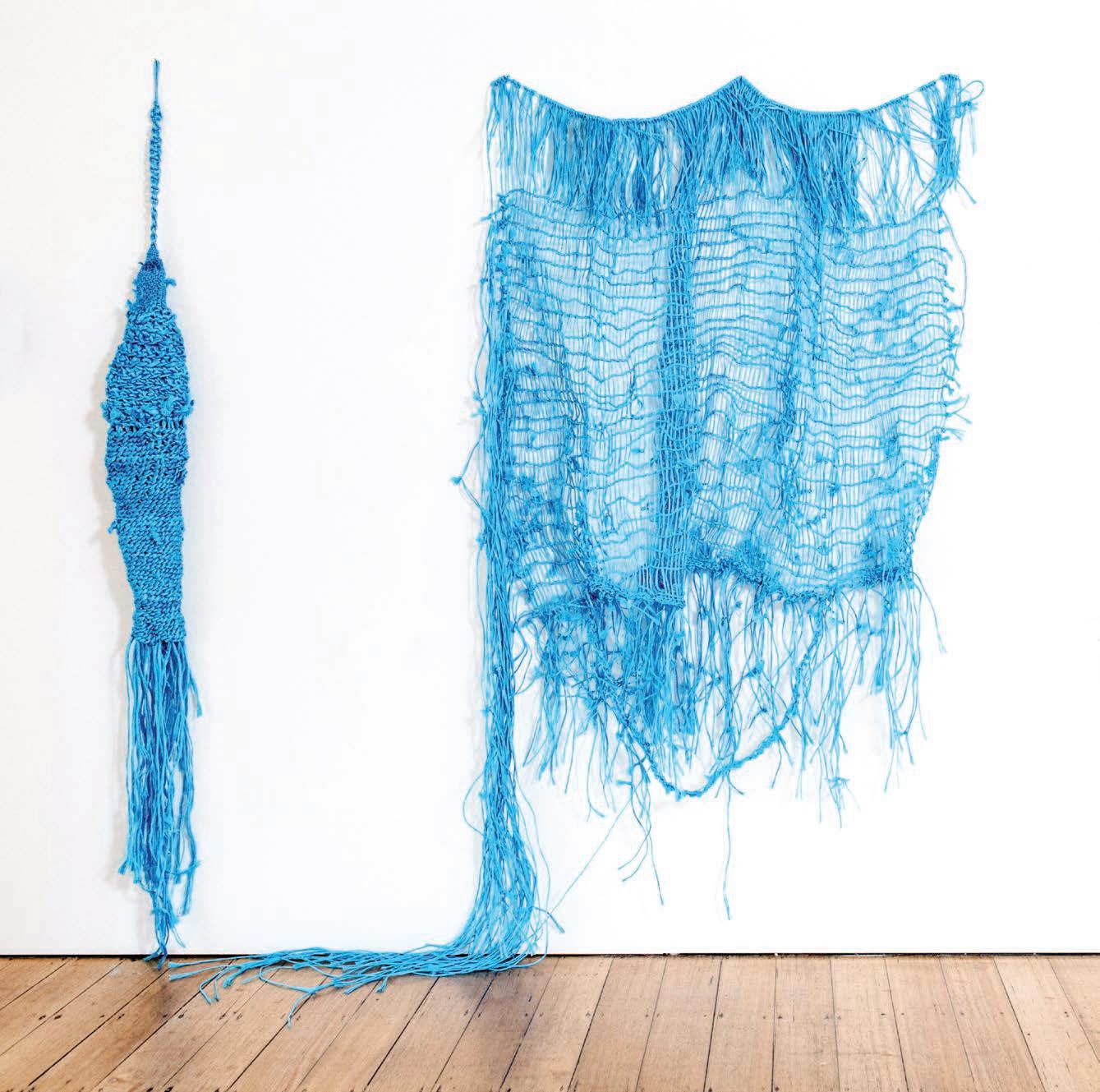
Carolyn Cardinet
Found blue baling twine – 11 pieces [detail] 2021-23
Repurposed baling twine and metal
Multiple parts; various dimensions
Photographer: Marie-Luise Skibbe
Carolyn Cardinet is a Melbourne-based environmental artist who has witnessed the coastal degradation caused by human activity such as climate warming and pollution in waterways. Exposed to the elements, plastic erodes into a multitude of tiny pieces which contaminate the environment and are eventually eaten by creatures, both large and small. Plastic constitutes one of the greatest threats to all sentient species on Earth.
The work on display is a direct response to that vital issue. It has been created from single-use
blue polyethylene plastic baling twine, one of the abundant plastics that promptly become discarded after one use only. This re-purposed, found twine has been inspiring to create with both in its materiality and its joyful colour. It naturally directed the work towards a continuing conversation around plastic pollution in waterways.
The techniques used in the works include macramé, crochet, stitching, coiling and weaving which transform and elevate waste-material into sculptural work.

Barbara Dover
Adrift 2021
Found marine debris – plastic disposable lighters 15 x 150 cm diameter
Photographer: Epic Media
Barbara Dover is a Cairns-based multidisciplinary artist whose practice draws on a range of processes, materials and found objects in the consideration of our interactions with the natural world. A primary focus of her installation and assemblage work is our relationship with animals within the understanding that they are sentient beings whose interests and lives matter.
This current body of work points to concerns about the impact of changing climate, rising sea levels, overfishing and, particularly, the devastation caused to ecosystems and animals by plastic pollution in waterways and oceans across the world. Marine plastic debris, collected from north Queensland coasts, has been used to make the works.
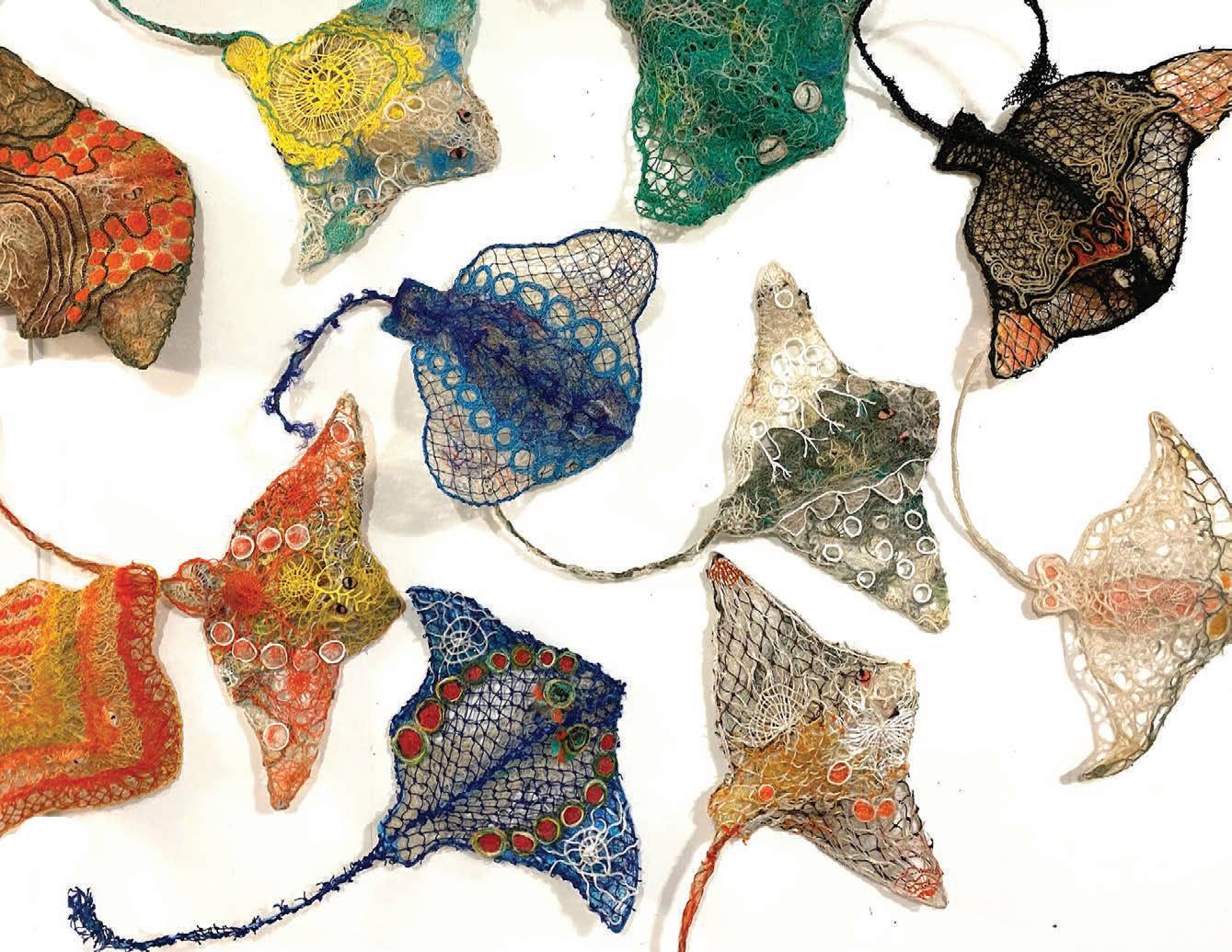
Ghost Net Collective – Marion Gaemers and Lynnette Griffiths
Fever of Rays [detail] 2022-23
Ghost net, beach rope and wire frame
Multiple parts; 55 x 60 x 15 cm each Photographer: Lynnette Griffiths
The Ghost Net Collective is part of a ‘world-wide art movement’ that is rapidly expanding, striving to generate awareness, recycling and sustainability options that will rid the world’s oceans of ghost net. As global solutions to this problem are developed, the Ghost Net Collective, Griffiths and Gaemers, along with other artists are leading the charge to visually present this problem to audiences by weaving and stitching massive installations that engage with conservation groups, children, museums, and collectors on a world stage.
This fever (collective noun) of rays is a symbol that represent all ocean creatures that are affected by discarded fishing net and rope. This harmful
material, gathered from the ocean is used to make the work. The material comes in a variety of colours as do rays.
Rays are found in the shallow waters around the Australian coastline. They come in a variety of shapes, sizes, and colour. Most people using the ocean will have a story about coming in contact with a ray. They are a sea symbol that people in coastal communities can relate to.
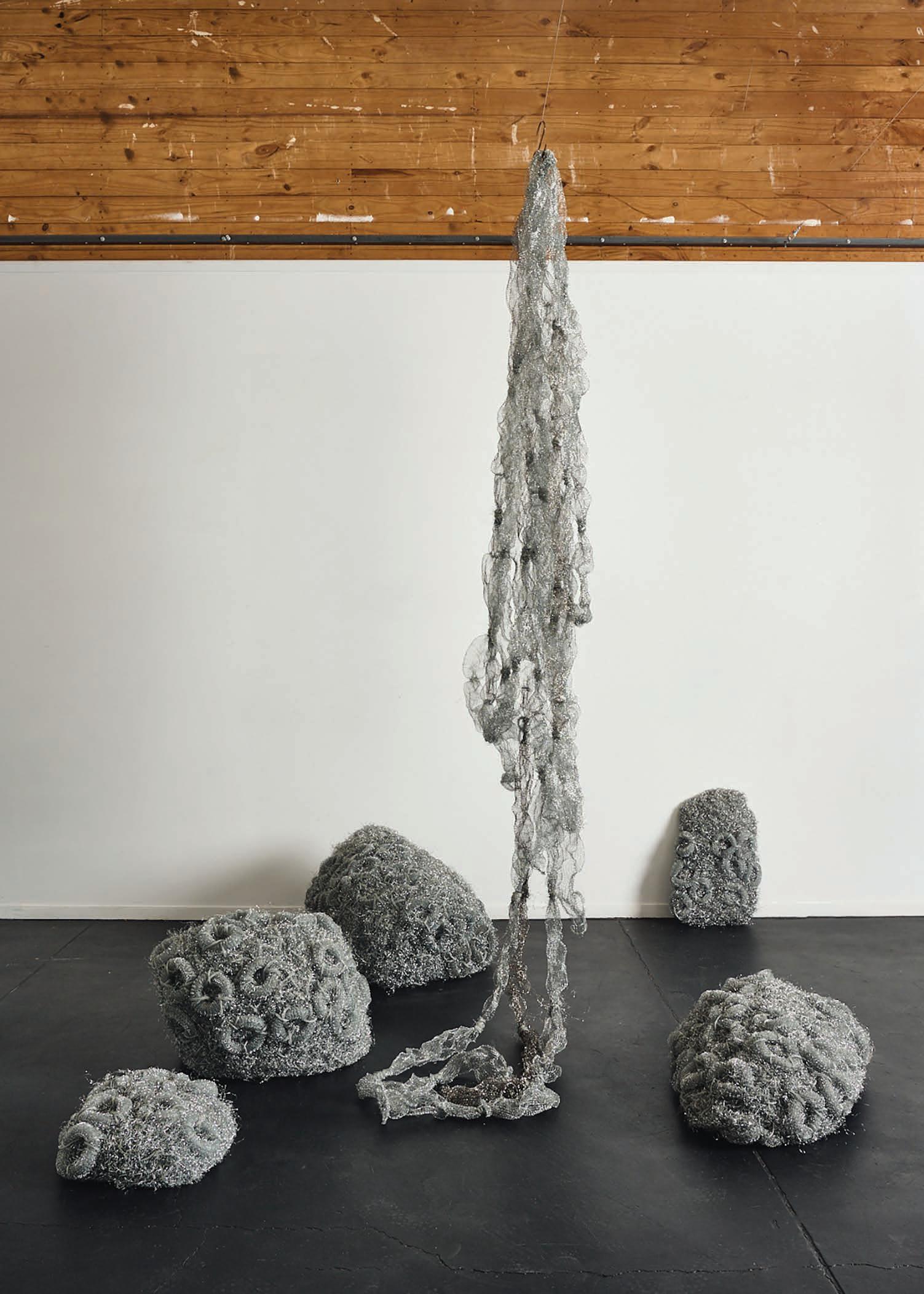
Carolyn Menzies Wash-up 2022
Stainless steel mesh, steel thread and braided wire
290 x 180 x 240 cm
Photographer: Kit Edwards
Carolyn Menzies is fascinated with the process of transformation. In particular, when metaphorise occurs in the slippage between the boundaries of human beings and nature. She creates abstract sculptures using craft processes with industrial materials and found objects. Producing multi-piece human-scale sculptures for gallery spaces Carolyn uses materials harvested from under the sink to create a delicate play of mass and volume in shimmering stainless-steel that follow the forms of growth and change we see in nature.
In our postcapitalist world the high-status objects with which we surround ourselves create a choregraphed story of self. With little assigned value, everyday objects and throw-away materials are a less rigidly controlled space of meaning and experience. Through the transformation of these elements the artist seeks to surprise the viewer in the belief that to experience the world made strange challenges the status quo makes space for new stories.
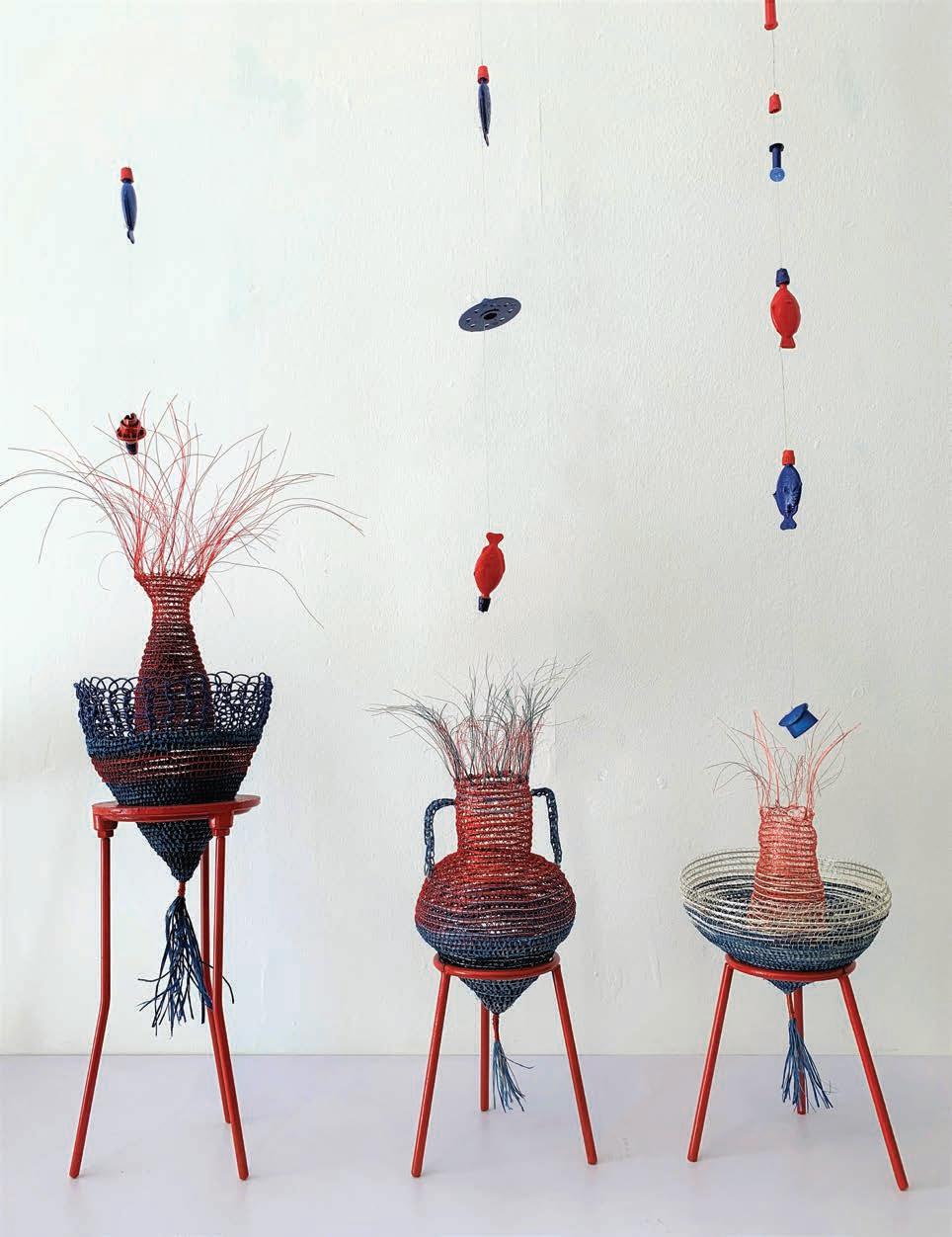
Helen Philipp
14 Pieces (Blue and Red Tintinnids) [detail] 2020
Coated copper wire, paper twine, raffia, repurposed plastic waste, repurposed metal stand and varnish
Multiple parts; various dimensions
Image courtesy of the artist
Helen Philipp uses enlarged photographs of plankton as inspiration for her exploration of form, colour and materiality in woven sculpture. Learning her craft through weaving bowls, Philipp was particularly intrigued by Tintinnids, microplankton, that when looked at under a microscope, resemble tiny vessels.
In 2019 Philipp stumbled on a scientific paper examining the profound effect of plastic in the marine environment, finding that 14 pieces of ingested plastic had a 50% chance of causing death in sea turtles. This prompted daily collection of discarded plastic on the St Kilda foreshore,
where Philipp lives and works: “straws, soya sauce containers, bottle-tops in abundance, thrown away by those who visit the beach or washed into our bay through storm water”.
The materiality of the plastics began to fascinate her as did the challenge of incorporating them into her woven forms in ways that enhanced and furthered the aesthetic, whilst simultaneously offering playful transformation of ‘waste’ into ‘art’, or debris repurposed in something which is valued.
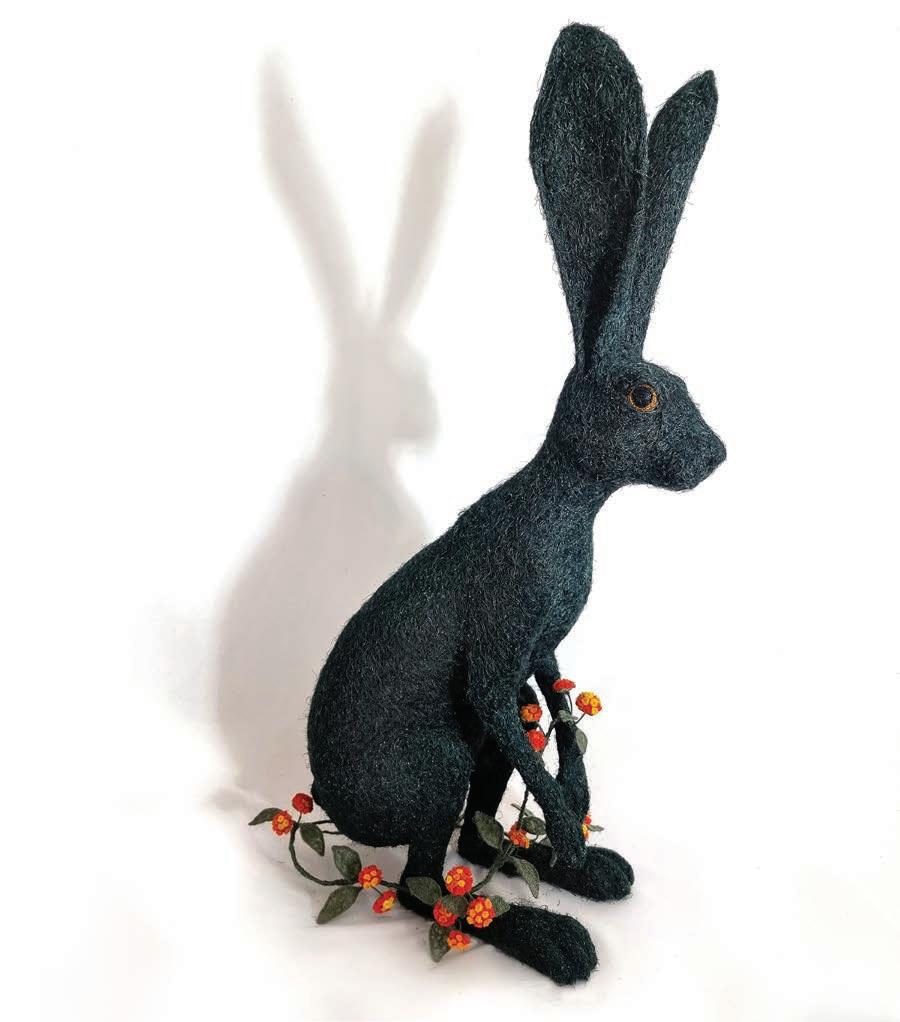
Sue Ryan
Immigrants 2023
Steel, wire, construction adhesive, insulation fibre, epoxy, ghost net, beach rope, fruit netting bags, nylon and polypropylene thread 102 x 70 x 43 cm
Image courtesy of the artist
Animals are commonly portrayed in my work, highlighting our relationship with the natural world, our connection and disconnection to it. My work explores personal narratives, mythology, form and gesture, whilst intuitively seeking the nature of things.
I’ve always been a scrounger and love adapting discarded materials to make sculpture. There is something about transforming a seemingly worthless material into a different form which fascinates me. Marine debris became a medium for me in 2009 when working with GhostNets Australia to investigate what could be made from the material. I never imagined I’d be making sculpture in this way. I certainly wasn’t a born stitcher, however it seems to have worked its way into my life. People usually ask of my work “what is it made from?” I often focus on personal themes yet the medium itself inevitably opens the wider dialogue of marine debris and plastics in the environment.
Rabbits, hares and many other animals were introduced to Australia for sport, food, as companion animals and to work beside us. I am curious how culture and perhaps genetic memory is so deeply embedded within us that it creates a foundation for how we perceive the landscape. Animals such as the rabbit and hare will be forever woven into my Irish, Celtic heritage. There is a fairy tale familiarity to these beings, yet are out of place in the Australian environment. Lantana was introduced as an exotic garden plant by European settlers but now dominates vast areas of bush land. It does however make a wonderful habitat for the hare, the rabbit and the feral pig.
The grandest of all mistakes though is the introduction of plastics which insidiously work their way into every ecosystem. As we strive forward to resolve one problem after another we seem to have an in-built short-sightedness for how our choices impact the future.
Carolyn Cardinet
Found blue baling twine – 11 pieces 2021-23
Repurposed baling twine and metal
Multiple parts; variable dimensions
Carolyn Cardinet
The Hourglass 2022
Repurposed baling twine and metal
250 x 60 cm diameter
Carolyn Cardinet
Microbeads Trap 2022
Repurposed baling twine
60 x 25 cm
Carolyn Cardinet
Vigourus Virus 2022
Repurposed baling twine and metal
55 x 55 cm
Barbara Dover
Adrift 2021
Found marine debris – plastic disposable lighters 15 x 150 cm diameter
Barbara Dover
Illuminate 2021
Found marine debris – plastic hard hats, found wire fish trap and LED lights
40 x 85 cm
Barbara Dover
In Memoriam 2021
Found marine debris – plastic packaging tags and wire
50 x 50 cm
Marion Gaemers and Lynnette Griffiths
Fever of Rays 2022-23
Ghost net, beach rope and wire frame
Multiple parts; 55 x 60 x 15 cm each
Marion Gaemers, Lynnette Griffiths, and community from Erub Arts, Torres Strait; Perc Tucker Regional Gallery members; Mary Who?
Bookshop Readers; Retreat Recreate, Melbourne; Zero Waste, Magnetic Island; Ingham Art Action Group and others
Community Fever of Rays 2023
Ghost net and beach rope
Multiple parts; 15 x 10 cm
Lynnette Griffiths
Chomp 2022
Ghost net and rope over aluminium frame
200 x 70 x 40 cm
Carolyn Menzies
Wash-up 2022
Stainless steel mesh, steel thread and braided wire
290 x 180 x 240 cm
Carolyn Menzies
Filter Feeder 2023
Stainless steel mesh, steel thread, steel rings and chain
290 x 140 x 130 cm
Carolyn Menzies
Dishwater Blonde 2023
Stainless steel mesh, thread and bead chain
130 x 35 x 35 cm
Helen Philipp
Entangled (a swoon of 23 Jellyfish) 2021-23
Copper wire, Viennese paper twine, Madagascan raffia, repurposed plastic waste and varnish
Multiple parts; various dimensions, 150 x 300 x 100 cm
Helen Philipp
14 Pieces (Blue and Red Tintinnids) 2020
Coated copper wire, paper twine, raffia, repurposed plastic waste, repurposed metal stand and varnish
Multiple parts; various dimensions
Helen Philipp
Engorged (3 Cephalopods) 2020
Raffia, paper twine, vintage buttons, repurposed waste plastic and varnish
Multiple parts; 40 x 60 x 15 cm each
Helen Philipp
Enmeshed (3 Jellyfish) 2021-23
Habu silk-wrapped paper thread, Viennese paper twine, Habu pompom thread and found plastic
Multiple parts; 90 x 20 x 20 cm each
Helen Philipp
Excreta (Long white and red Tintinnid) 2021
Coated copper wire, repurposed discarded plastic, repurposed metal stand and repurposed fruit bags
Multiple parts; 80 x 15 x 15 cm
Sue Ryan Immigrants 2023
Steel, wire, construction adhesive, insulation fibre, epoxy, ghost net, beach rope, fruit netting bags, nylon and polypropylene thread
102 x 70 x 43 cm
Jane Scott Galleries Director
Jo Lankester Senior Exhibitions and Collections Officer
Sascha Millard Collection Management Officer
Veerle Janssens Collection Registration Officer
Leo Valero Exhibitions Officer
Michael Favot Exhibitions Assistant
Chloe Lindo Curatorial Assistant
Rachel Cunningham Senior Education and Programs Officer
Jonathan Brown Education and Programs Officer
Ashleigh Peters Education and Programs Officer
Tanya Tanner Senior Public Art Officer
Caitlin Dobson Public Art Officer
Katya Venter Gallery Assistant
Zoe Seitis Gallery Assistant
Maddie Macallister Gallery Assistant
Rhiannon Mitchard Gallery Assistant
Anja Bremermann Gallery Assistant
Deanna Nash Team Leader Business Support
Sue Drummond Business Support Officer
Christine Teunon Business Support Officer
Emma Hanson Business Support Officer
Rachael Devescovi Business Support Officer
